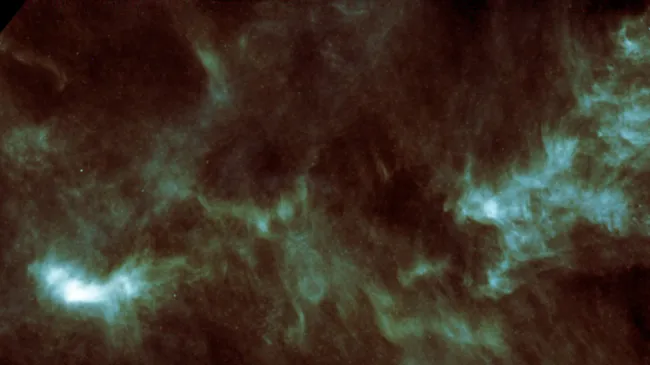Scientists found “nitriles” in interstellar cloud
- November 12, 2024
- 0
Scientists have found two nitrile-containing molecules in the molecular cloud of Taurus, one of the closest star nests to Earth, and this is incredibly interesting because it is
Scientists have found two nitrile-containing molecules in the molecular cloud of Taurus, one of the closest star nests to Earth, and this is incredibly interesting because it is

Scientists have found two nitrile-containing molecules in the molecular cloud of Taurus, one of the closest star nests to Earth, and this is incredibly interesting because it is these molecules that can reveal information about the origin of life in the universe as we know it. BT.
The Taurus Molecular Cloud (TMC-1) is an interstellar cloud located in the constellations Taurus and Voznych, and the recently discovered molecules within it are known as malononitrile and maleonitrile. The molecules were discovered using data from the ongoing QUIJOTE TMC-1 survey of the Yebes telescope in Spain. In short, their existence suggests that complex chemical processes occur in space; These processes may hold clues to the truth about how life emerged.
“Dinitriles such as malononitrile have been recognized as precursors in the prebiotic synthesis of purines and pyrimidines, which are the basis of RNA and DNA,” explained researcher Marcelino Agundez Chico from the Institute of Fundamental Physical Sciences (CSIC) in Madrid. Spain, reported Space.com. “The more we research, the more we understand that molecular clouds can synthesize prebiotic molecules.”
In recent years we have witnessed an exciting phase in astrochemistry, where new observation techniques and advanced telescopes are allowing scientists to detect bursts of new molecules in space with astonishing complexity. “There appears to be no limit to the degree of chemical complexity that interstellar space can produce,” Agundez said. “Cold interstellar clouds are no longer considered dormant places but very active chemical laboratories.”
Among all the common types of molecules, there are those that contain a nitrile group consisting of triple bonds between carbon and nitrogen atoms. Such molecules are actually extremely abundant. “The nitrile group is extremely stable,” Agundez said. “Carbon and nitrogen are held together by a triple bond, one of the strongest chemical bonds in nature.”
But interstellar chemistry differs from the chemistry that occurs on Earth, where reactions generally lead to the most stable products. In space, a cold, low-energy environment, the outcome of chemical reactions depends on the rate or probability of the reaction rather than its stability. This means that fast reactions tend to dominate slower reactions, even if they do not lead to the most stable products. Nitriles are very common in space in general, which tells us that they are not only easy to form but also very resistant to destruction.
This stability, combined with their likelihood of formation, actually makes nitriles more common than other types of molecules that can dissociate or react more easily. To connect the newly discovered nitrile molecules to the chemistry that could give rise to life on Earth, astrochemists need to determine the interstellar reactions that give rise to them. Therefore, Agundez and his colleagues investigated other molecules that could serve as starting materials for the two nitriles they discovered, offering potential insights into the reaction pathways involved in their formation.
Here’s what they found.
The team reported that malononitrile and maleonitrile were eight and three times less abundant in the TMC-1 cloud, respectively, compared to similar molecules in which one of the nitrogen triple bonds was replaced by a carbon-carbon triple bond.
Possible reactive species known as “radicals”, which can lead to both the carbon-carbon triple bond and the formation of malononitrile and malononitrile-containing molecules, were also found to be approximately ten times more abundant in the carbon form compared to pre-nitrile radicals. . “[Потрійний зв’язок вуглець-вуглець] Once formed, it is very difficult to break and TMC-1 is rich in hydrocarbons, Agundez said. Therefore, it is not surprising that carbon-based molecules are more abundant than nitrile-based molecules.
Using chemical modelling, the team was able to propose a reaction pathway for the production of maleonitrile. But the researchers encountered a wall containing malononitrile; they could not prove how this formed in the cold interstellar cloud.
According to Agundes, this stems from a challenge facing the industry: The pace at which new molecules are being discovered is outpacing the ability of existing models to explain how they form. For example, maleonitrile is not currently included in chemical databases.
“The tremendous speed at which molecules unfold in space [за останні] “It cannot be digested by chemical models for a period of three years or so,” Agundez explained. “Many of the molecules discovered are not even included in the reaction networks used in astrochemistry. We need to investigate many new reactions to understand how they are formed.”
Agundez says they are currently working on a solution that will be published in a future study. But the data collected here and data from other research studies are helping to create a growing platform of knowledge that scientists can use to unravel the mystery of life in the universe and perhaps one day find it elsewhere. .
“The data we have for other clouds is not as sensitive, but there is no reason to think TMC-1 is special,” Agundez said. “It is very likely that the chemistry we detected in TMC-1 also occurs in many other molecular clouds in our galaxy.
“The fact that we now know they are abundant in interstellar clouds adds an additional piece to the puzzle of prebiotic molecules that we are sure are synthesized in interstellar space,” he concluded.
Source: Port Altele
As an experienced journalist and author, Mary has been reporting on the latest news and trends for over 5 years. With a passion for uncovering the stories behind the headlines, Mary has earned a reputation as a trusted voice in the world of journalism. Her writing style is insightful, engaging and thought-provoking, as she takes a deep dive into the most pressing issues of our time.